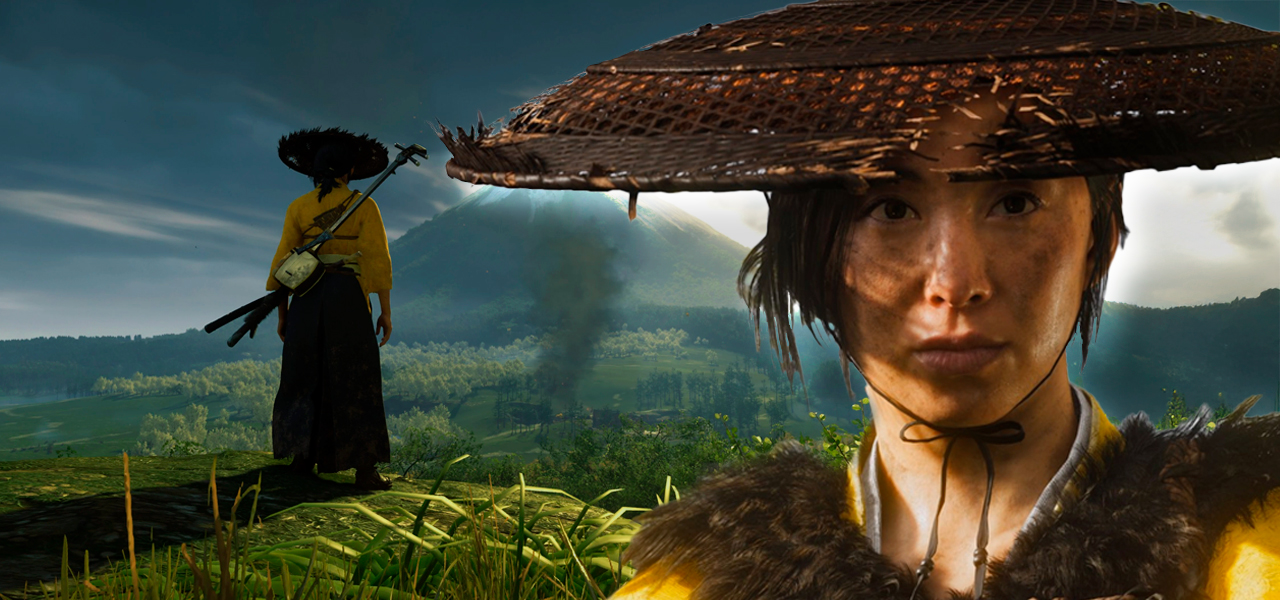Ghost of Yotei – First Impressions on Accessibility
For many years, I have admired the culture of ancient Japan. Whether through historical books and films, or fictional works rooted in the samurai epic, video games naturally drew my close attention as well. I believe I would not be exaggerating if I said that everyone who rewatched The Last Samurai or followed the adventures of Rurouni Kenshin has at some point dreamed of stepping into the shoes of a great warrior, katana gleaming in the sunlight, felling hordes of enemies with a few lightning-fast strikes.
Unfortunately, I have not found many playable projects on this theme, though those that exist are quite interesting. For example, Samurai Warriors 4 — an epic hack-and-slash where legendary heroes of the Warring States period cut through massive crowds of foes, or Samurai Riot — a two-dimensional beat ’em up with eight different endings and a surprising number of tough choices. But today we will not be talking about them.

Ghost of Tsushima: Barriers and Solutions
I first discovered the work of the Sucker Punch studio when Ghost of Tsushima launched in 2020. At the time, the game was released as a PS4 exclusive and, sadly, it was impossible to complete it alone as a blind player. However, with the help of a friend, I was able to experience the stunning story of Jin Sakai. The game was outstanding in terms of sound design, soundtrack, and overall direction.
Time passed, Sony’s console generation shifted, and the developers presented a PS5 version of the game that brought many notable improvements: haptic feedback on the DualSense controller, the cooperative “Legends” mode, and a story expansion. Thanks to the controller’s feedback, it became possible to attempt playing blind, relying on the mechanic of the guiding wind, which points toward the selected map marker. I must admit, it was still a very difficult journey requiring immense patience, but true samurai never give up — they push forward with honor.
Later, Sucker Punch released the game on PC, and here blind players saw a glimmer of hope. On computers, games often gain new possibilities thanks to mods and other tools. One day, a blind friend of mine told me that he was successfully progressing through Tsushima by using a trainer — specifically, just two functions of it: teleporting to a marked location on the minimap, and invisibility for segments where the game forces stealth.
Naturally, I wanted to see for myself how such features changed the experience, and it was incredible. If you got lost in the vast locations, a single key press teleported you to your quest marker, and almost anything could be marked on the map. Yes, this was not a perfect solution, but far better than nothing. The joy I felt when I managed to complete Jin’s story largely on my own is hard to describe — I only needed sighted help around four times in the entire game, and even then only for a couple of minutes each. Ghost of Tsushima deserves a dedicated review, but that will be a topic for another day.
Ghost of Yotei: A New Journey and the Main Question
Naturally, after immersing myself in that story, I wanted more. And so I was thrilled when the developers announced the sequel, Ghost of Yotei, set 300 years after the events of the first game.
I awaited the project with impatience, and on October 2, 2025, the game was released — for now exclusively on PS5 — and I got my hands on it right away.
The key question is: how playable is this second installment for fully blind gamers? After spending several hours with Sucker Punch’s new creation, I will try to answer. I should stress that these are only first impressions — I have not yet completed the game, and later I may encounter sections that are completely impassable without sighted assistance. I mean not just the occasional minute-long challenges of Tsushima, but entire gameplay segments. So, let’s dive into this new adventure and visit the island of Hokkaido in the year 1603.
Storyline
Ghost of Yotei is a story of vengeance, solitude, and willpower. Set against the harsh, icy land of Ezo, where ancient customs intertwine with the mystical power of spirits, the mercenary Atsu returns to take revenge on the band that destroyed her family. Yet the path of vengeance quickly turns into a path of self-discovery: behind the mask of the Ghost lies not only a warrior, but also a human being searching for her place in a world where the line between honor and bloodlust grows thinner by the day.
First Launch
Upon pressing “Play,” the Sony logo appears, echoed through the DualSense controller’s haptics. Next, we reach a menu without screen-reader support. That has never stopped me before: by using NVDA’s OCR — since I play via a capture card that streams the console’s video output to my PC — I learned that the first prompt was brightness adjustment. Without changing anything, I pressed the Cross button and moved on to the next menu, where the game immediately asked me to choose the difficulty level. I must note that, in both games of the series, OCR performs exceptionally well.
After setting the difficulty, we are asked to choose a visual mode. While the Kurosawa film filter also alters the sound — making it resemble recordings from 1960s cinema — this is unsuitable for blind play. I left the standard mode enabled, pressed “Continue,” and was dropped into an atmospheric cutscene that set up the story.
We are shown the heroine as a child, as well as the main antagonist. Later, an older Atsu narrates her harsh journey and her motivation to avenge her loved ones.
The transition to gameplay is done in a stylish, intriguing way: using the touchpad, the player must write the names of Atsu’s six targets, the people she will hunt down.
I quickly figured out how to do this without help. Fortunately, the tactile vibration strongly indicated whether my finger was moving in the right direction.
Then Atsu declares that her first target will be the Snake, whom she has tracked to a certain village — and the prologue begins.
Gameplay and Settings
Once I gained full control of the character, the first thing I did was swipe upward on the touchpad — and to my joy, the guiding wind was available right from the start, perfectly conveyed through haptics. I immediately wanted to check the settings menu for accessibility options.
The settings were divided into tabs such as Gameplay, Controls, Audio, Display, and Accessibility. OCR continued to perform reliably, and once I navigated to the right tab, I explored which features might help blind players.
Among many visual settings, I found one I had to reread several times in disbelief: “Automatically turn the camera toward the objective when using the guiding wind.” I enabled it without hesitation. Other useful options included removing time limits from QTE segments, aim assist, and simplified target lock-on in melee combat.
In the audio section, I lowered the music volume to focus on environmental sounds. Returning to the checkpoint, I tested the camera-turning feature — and yes, it worked! I reached the next cutscene with ease, then fought enemies and a mini-boss without any major issues. At one point Atsu mentioned returning home after many years. I worried that navigation might fail me, as it has in other games (for example, Horizon Forbidden West), but no: I was able to ride my horse back and even found a memory sequence from Atsu’s past.
In this memory, her family is still alive. After a game of tag with her brother — aided again by wind and dialogue cues — Atsu’s mother awaits her for a shamisen lesson. This mechanic was wonderfully atmospheric: using the touchpad and careful listening, I had to pluck the correct strings to match notes.
Then Atsu’s father, a blacksmith, allowed her to help forge a blade. This required gyroscope input: lifting and lowering the DualSense to hammer, pressing buttons to flip or heat the metal. By paying attention to the sound of hammer strikes, I could tell when to flip or reheat the blade. Finally came a sparring duel with her brother, teaching the combat basics. Here too I had no difficulty — the voice prompts were clear, and since I had finished the first game, the controls felt familiar.
After this sequence, the game sent Atsu on another quest. Navigation once again worked reliably. Eventually, I unlocked the map and upgrade menu; OCR handled these well too, allowing me to set waypoints, read quest descriptions, and browse categories using the D-pad. I decided to visit a dual-katana master, reportedly far across the map according to my wife, as a stress test for the navigation system. It did not disappoint.
Challenging Sections
Reaching the base of Mount Yotei, Atsu begins her climb in search of the old master — and here I encountered the first real challenge. Though the wind was helpful, vertical gameplay was still difficult. These very high ascents also existed in Tsushima, but teleportation mods on PC removed most of the frustration. From this, I conclude that a future PC version of Yotei will likely be more manageable with similar tools.
Still, with enough patience and attention — feeling the wind’s direction through haptics and listening carefully to audio — it is possible to climb without help. But if you have the option to ask a sighted person, don’t hesitate.
Later came a bamboo-cutting mini-game. Two of the three stages were easy enough, but the last one stumped me. I could not figure out why until my wife explained that it required pressing the D-pad in a specific sequence — for example, left, down, right, up.
An idea struck me afterward: one could take a screenshot, feed it to an AI model, and ask for the sequence — useful when no sighted help is available. I may even write a guide for this mini-game and publish it on the project’s site. The subsequent dual-katana quest presented no issues.
Initial Evaluation
By this stage I had progressed through several more quests, unlocked another weapon type, and explored various points of interest on horseback. Navigation continued to prove dependable. Combat should not pose major problems either, as excellent sound design and spatial audio offer strong support.
Overall, I strongly recommend playing with a capture card or, at the very least, the console’s Remote Play function, combined with NVDA’s OCR in continuous recognition mode.
The only significant difficulty so far has been climbing extreme heights. Even then, with practice, I suspect it may become somewhat manageable.
In any case, Ghost of Yotei marks another solid step forward in the series’ accessibility. As I often say, navigation is the greatest barrier for blind players. Everything else — combat, menus, even interfaces — can usually be mastered by ear or with OCR. But without good navigation, all the accessibility work collapses. Far Cry 6, Assassin’s Creed Valhalla, and Atomfall are prime examples of this problem.
To conclude: I will certainly continue Atsu’s journey, and I hope the game contains very few moments where sighted help is absolutely required for progression. Once I finish, I will publish another article with my final verdict on whether the console version is worth playing now, or whether it is better to wait for the PC release — which may combine the game’s built-in accessibility with external solutions, just like the first part of the series.
For now, I bid you a short farewell, dear readers. Very soon, we will meet again in the vast expanse of our invisible ocean of possibilities.
